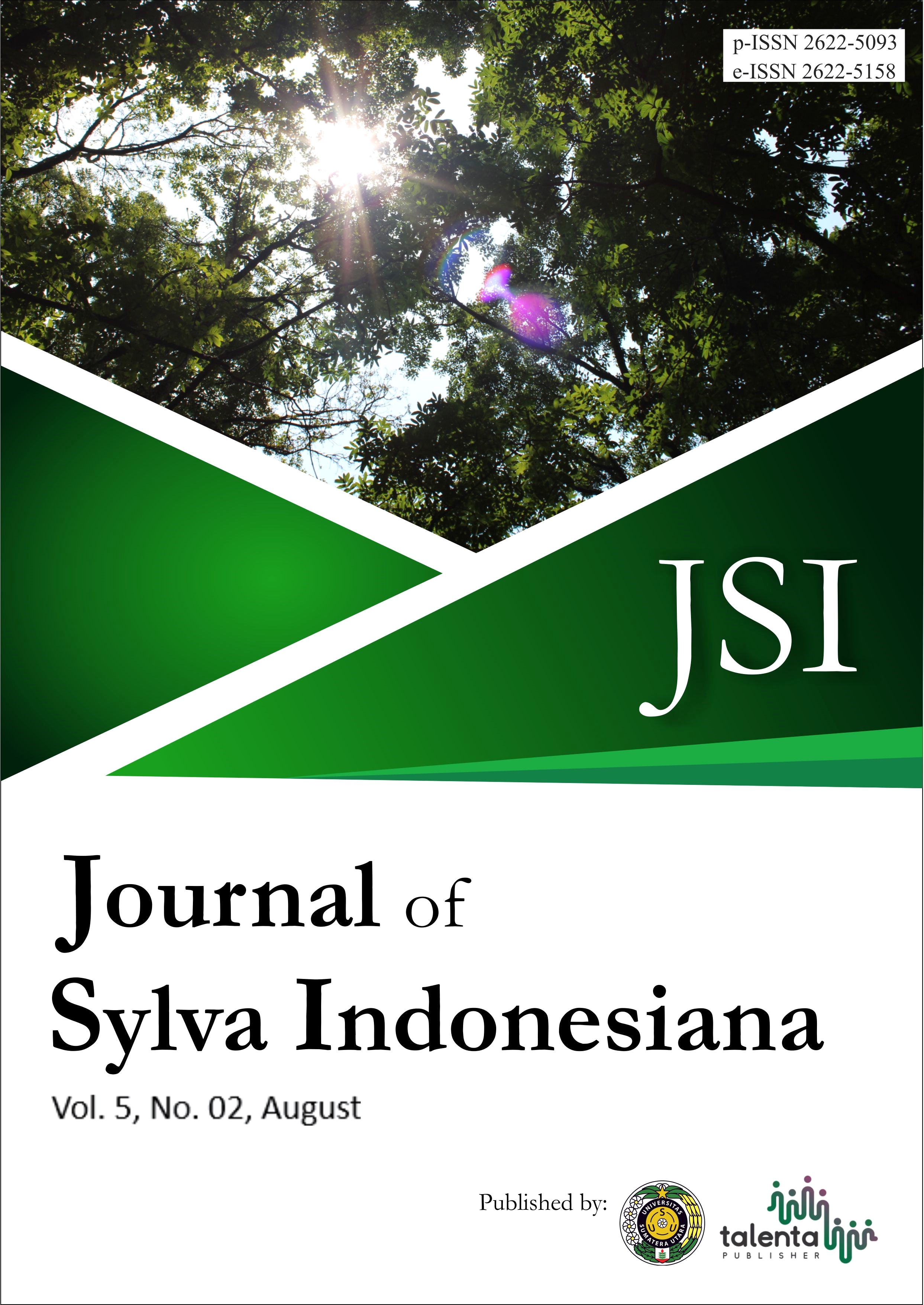Culm Characteristics of Yellow Bamboo (Bambusa vulgaris var. striata) from Private Forest in Sleman Regency, Yogyakarta
DOI:
https://doi.org/10.32734/jsi.v5i02.7536Keywords:
Bamboo Internode, Bamboo Clump, Regression, Modelling, Non-timber Forest ProductsAbstract
Sleman Regency has determined bamboo as a superior non-timber forest product. Yellow bamboo (Bambusa vulgaris var. striata) is usually used for construction and craft materials. Hence, it is necessary to understand the characteristics of the culm. The study aimed to determine the predictor variables for the total internodes, and the distribution pattern of the length and bamboo wall thickness of the internodes on the yellow bamboo culms. The method used in this research was the method of destructive sampling for 30 bamboo culm samples. The samples were measured using a caliper for diameter at breast height and wall thickness, and measurement tape for the total length of the bamboo culm. For detail measurement, each sample was cut for each internode to be measured the length, diameter, and wall thickness of the internodes. The results showed that the predictor of diameter at breast height (dbh) is a predictor in estimating the total number of internodes on the culm resulting in an R2 of 0.631. While the total culm height as a predictor was able to explain the total number of internodes with an R2 value of 0.692. The length of the internodes pattern on the yellow bamboo culm from the bottom to the top side formed a bell curve. In the middle area of the culm, the length of the internode increased, but then it shrank back to the top side. The diameter and wall thickness patterns of the internode were non-linear. In addition, the predictors of diameter at breast height and total height are less accurate to explain the total number of internodes in yellow bamboo culms.
Downloads
References
Kementerian Kehutanan Republik Indonesia, Peraturan Menteri Kehutanan Nomor: P.35/Menhut-II/2007 Tentang Hasil Hutan Bukan Kayu. 2007.
B. Mulyana, Rohman, and W. Wardhana, “Luas Optimum Petak Ukur Untuk Hutan Tanaman Kayu Putih Di Kesatuan Pengelolaan Hutan Yogyakarta,†J. Faloak, vol. 2, no. 1, pp. 29–38, 2018.
B. Mulyana, S. W. S. Siallagan, T. Yuwono, and R. H. Purwanto, “Daur Optimum Pemangkasan Daun Kayu Putih Di KPH Yogyakarta,†J. Penelit. Kehutan. Wallacea, vol. 8, no. 1, pp. 71–79, 2019.
B. Mulyana, R. H. Purwanto, Rohman, and R. Reorita, “Allometric model to estimate biomass of leave-twigs cajuput (Melaleuca cajuput) at KPH Yogyakarta, Indonesia,†in IOP Conference Series: Earth and Environmental Science, 2021, vol. 724, p. 012084.
P. M. Utomo, E. Suhendang, W. Syafii, and B. C. Simangunsong, “Model produksi daun pada hutan tanaman kayu putih (Melaleuca cajuputi Subsp cajuputi. Powell) sistem pemanenan pangkas tunas,†J. Hutan Tanam., vol. 9, no. 4, pp. 195–208, 2012.
W. Setya, B. Irawan, E. Suhendang, and J. R. Matangaran, “Model Penduga Produksi Kopal Prediction Model for Copal Production Metode Penelitian,†vol. XIII, no. 3, pp. 166–171, 2007.
Kementerian Lingkungan Hidup dan Kehutanan, Statistik 2019 Kementerian Lingkungan Hidup dan Kehutanan. Jakarta: Kementerian Lingkungan Hidup dan Kehutanan, 2021.
A. Hani, E. Fauziyah, T. Widyaningsih, and D. Kuswantoro, “Potency and Agroforestry Patterns that Support Bamboo Sustainability in Sukaharja Village, Ciamis District,†J. Wasian, vol. 5, no. 2, pp. 115–125, 2018.
A. Hani, “Dendrocalamus asper productivity after beginning thinning,†IOP Conf. Ser. Earth Environ. Sci., vol. 449, no. 1, 2020.
A. Mayasari and A. Suryawan, “Keragaman jenis bambu dan pemanfaatannya di Taman Nasional Alas Purwo,†Info BPK Manad., vol. 2, no. 2, pp. 139–154, 2018.
Bupati Sleman, Surat Keputusan Bupati Kabupaten Sleman No. 306/Kep.KDH/A/2013 tentang Hasil Hutan Bukan Kayu Unggulan Kabupaten Sleman. 2013.
P. dan K. K. S. Bidang Kehutanan dan Perkebunan Dinas Pertanian, “Potensi bambu di Kabupaten Sleman,†Sleman, 2014.
D. Machfyroh, “Simpanan dan nilai ekonomi karbon bambu ampel gading (Bambusa vulgaris var. striata) di hutan Kecamatan Pakem Sleman Yogyakarta,†Universitas Gadjah Mada, 2021.
A. Sujarwanta and Z. Suharno, Jenis-jenis bambu dan potensinya: etnobotani bambu oleh masyarakat lokal Indonesia. Lampung: Laduny Alifatama, 2020.
Yanthi., N. Eka, I. Oka, and I. Surata, “Studi analisa manfaat dan tingkat pengetahuan masyarakat tentang tanaman upakara Hindu di Kabupaten Tabanan,†Mhs. Pendidik., vol. 2, no. 1, pp. 1–8, 2020.
K. Chaowana, S. Wisadsatorn, and P. Chaowana, “Bamboo as a sustainable building material-culm characteristics and properties,†Sustainability, vol. 13, pp. 1–18, 2021.
A. Bahanawan, T. Darmawan, S. Sufiandi, and W. Dwianto, “Mengenal bambu sembilang (Dendrocalamus giganteus Wallich ex Munro): Studi karakteristik batang species bambu raksasa,†in Prosiding Seminar Lignoselulosa 2018, 2018, pp. 97–100.
T. F. P. Hakim, P. Widodo, and E. Sudiana, “Variasi Morfologi Bambu Tali [Gigantochloa apus (Schult.F.) Kurz.] pada berbagai ketinggian tempat di Sub Daerah Aliran Sungai Pelus,†Biosfera, vol. 32, no. 1, p. 42, 2015.
P. Singnar, A. J. Nath, and A. K. Das, “Culm characteristics and volume-weight relationship of a forest bamboo (Melocanna baccifera (Roxb.) Kurz) from northeast India,†J. For. Res., vol. 26, no. 4, pp. 841–849, 2015.
A. Inoue, “A model for the relationship between form-factors for stem volume and those for stem surface area in coniferous species,†J. For. Res., vol. 11, no. 4, pp. 289–294, 2006.
A. Inoue, S. Sakamoto, H. Suga, and F. Kitahara, “Estimation of culm volume for bamboo, Phyllostachys bambusoides, by two-way volume equation,†Biomass and Bioenergy, vol. 35, no. 7, pp. 2666–2673, 2011.
C. R. Sanquetta, M. N. Inoue, A. Paula, D. Corte, and S. P. Netto, “Modeling the apparent volume of bamboo culms from Brazilian plantation,†no. October, 2015.
H. Suga, A. Inoue, and F. Kitahara, “Derivation of two-way volume equation for bamboo, Phyllostachys pubescens,†J. For. Res., vol. 16, no. 4, pp. 261–267, 2011.
A. Inoue, S. Sakamoto, H. Suga, H. Kitazato, and K. Sakuta, “Construction of one-way volume table for the three major useful bamboos in Japan,†J. For. Res., vol. 18, no. 4, pp. 323–334, 2013.
A. Inoue, “Culm form analysis for bamboo Phyllostachys pubescens,†J. For. Res., vol. 24, no. 3, pp. 525–530, 2013.
L. Abdulah and Sutiyono, “Model taper bambu betung,†J. Penelit. Hutan Tanam., vol. 16, no. 1, pp. 47–57, 2019.
Downloads
Published
How to Cite
Issue
Section
License

This work is licensed under a Creative Commons Attribution-NonCommercial 4.0 International License.



















